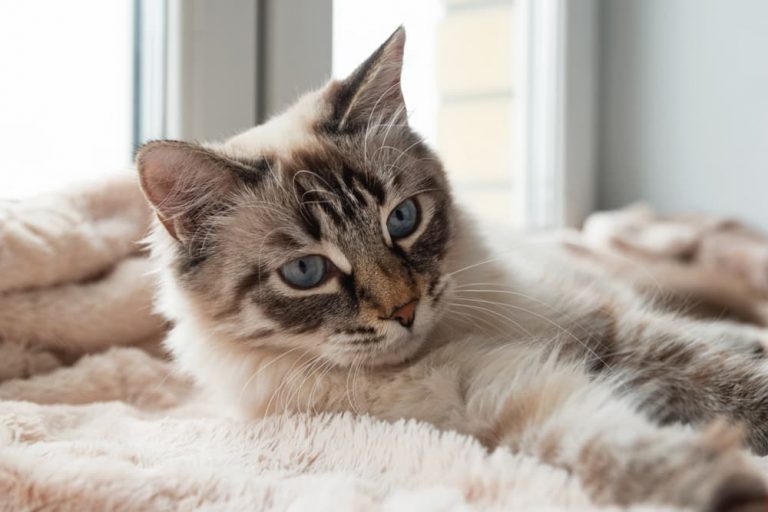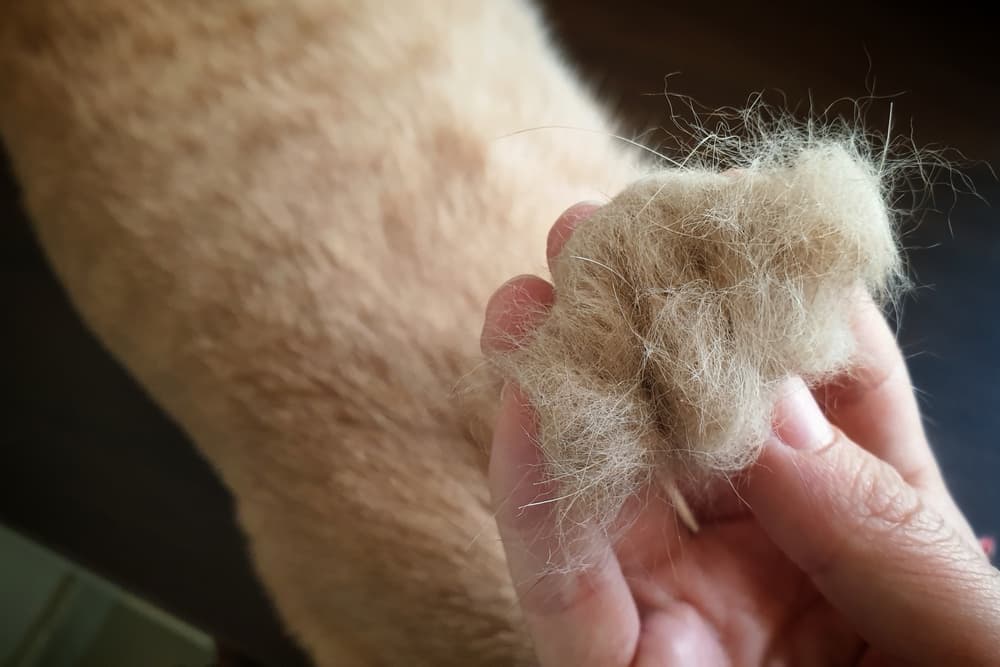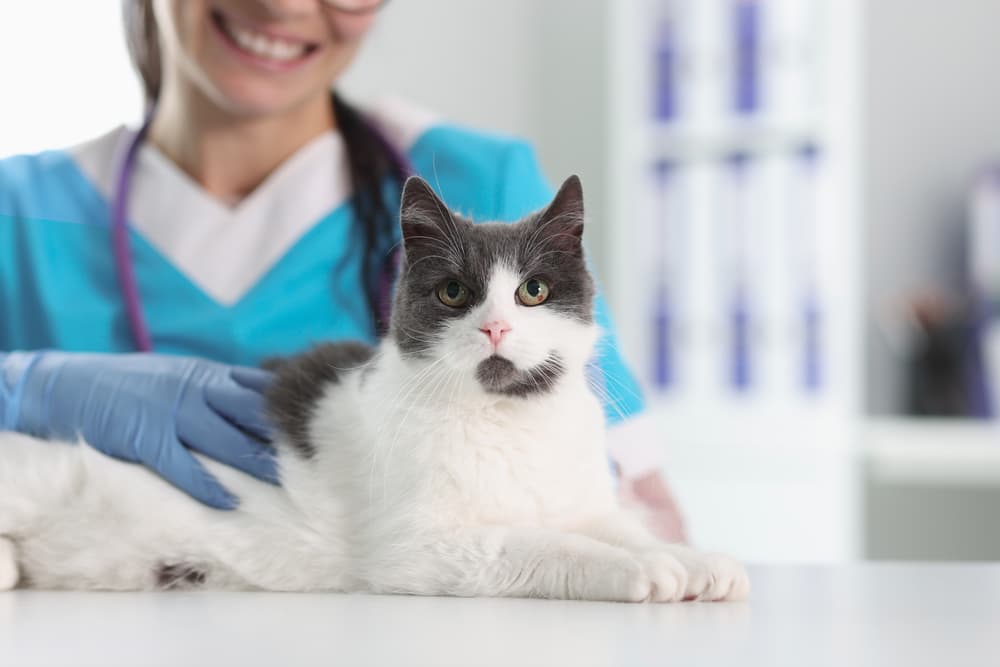Cat Hairballs: Why They Happen and How to Handle Them

If cleanliness is next to godliness, it’s no wonder why cats, being the meticulous groomers they are, require us humans to worship them as the little furry gods they believe themselves to be. However, a cat’s cleanliness and fussy grooming behavior can have one unpleasant consequence: hairballs.
Scientifically-named trichobezoars, feline hairballs are unpleasant, upchucked packages from our kitty overlords that we have to scrub off our carpet (fun fact: dogs can occasionally have hairball issues, too!). While hairballs are common, they may be a sign of an underlying health issue in your cat and can pose problems.
What Does a Cat Hairball Look Like?

Most cat hairballs are tubular-shaped, however, some may look more like smaller, rounded or formless clumps of matted hair or even a few stray hairs in a bit of liquid. Hairballs look a bit wet and slimy or frothy due to the saliva or gastrointestinal contents that coat them. These GI contents may tint the hairballs a yellow or dark brown hue and can sometimes cause them to be confused with stool or regular vomit, although they’re not as smelly. Hairballs may range in size from dime-sized to finger-length.
Contrary to popular belief, cats do not cough up hairballs. Hairballs are vomited, not expelled by coughing. Some pet owners may confuse a true cough with an attempt to throw up a hairball. If your cat is making a “hacking” noise, but no hairball is coming up, your cat may be coughing, which can be a sign of a respiratory issue and requires a vet exam.
When your cat is about to expel a hairball, he or she may vocalize just before vomiting, lower the head and body with the neck outstretched, gag or retch, and may swallow several times after eliminating the hairball. Keep in mind that if you’re not seeing actual hairballs in your cat’s vomit, another health condition causing vomiting may be at play, requiring a vet visit to investigate and treat the trigger for your cat’s vomiting.
What Causes Hairballs in Cats?

Adult cats can spend up to 25 percent of their time bathing themselves. A cat’s rough tongue, with its backward-facing barbs (papillae) that “comb” through his or her hair while licking, picks up dirt, bugs and other debris that has accumulated on the fur and skin, including loose hair. Hair and debris are swallowed, and hair is largely indigestible, so a hairball can develop in the stomach over time due to a cat’s innate grooming behavior. When the fur clump begins to irritate the lining of your cat’s stomach, vomiting is triggered to expel it.
Early domesticated cats didn’t have as much hair to groom, and though their coats may have evolved, their digestive tracts haven’t changed all that much. Therefore, while most short-haired cats handle hairballs quite well, long-haired cats may have more problems due to the increased amount of fur they inadvertently swallow upon grooming. These cats are more likely to have vomiting issues associated with their hairballs and are also at increased risk of developing intestinal obstruction.
Long-haired breeds that may struggle more with hairballs include Persians, Himalayans, Ragdolls, Maine Coons, Norwegian Forest Cats, Siberians, Turkish Angoras and Domestic Long Hairs.
Fortunately, kittens are less likely to develop hairballs because young cats haven’t quite learned to clean their coats as thoroughly as their adult counterparts, so hairballs are less commonly a concern for them.
Are Cat Hairballs Normal?

While common, cats vomiting up a hairball is not medically normal. In a healthy cat, the fur that is swallowed during grooming should be able to pass through the intestines and exit with the stool during a normal bowel movement.
While a cat’s normal grooming behavior causes the development of a hairball, the way he or she eliminates the hair may not be normal. If your cat is easily vomiting up a hairball only once per week or less, a vet visit is likely not needed.
However, if your cat is vomiting up hairballs more frequently (several times a week or daily), a trip to the vet is highly advised since an underlying gastrointestinal disorder may be to blame. Other factors can also increase your cat’s risk of vomiting up furballs.
As discussed, long-haired cats are predisposed to hairballs and are at least twice as likely as short-haired breeds to vomit a hairball due to the greater amount of hair they swallow during grooming.

Overgrooming or compulsive grooming behavior can also increase the likelihood that a cat will have hairball issues. Overgrooming can be instigated by stress or anxiety (including fretting over a dirty litter box), pain (a cat may obsessively lick a painful region of the body), hair mats, skin disease (such as allergies), or ectoparasites (such as fleas).
Additionally, certain digestive disorders can also lead to more hairballs. Gastrointestinal motility disorders (when the GI tract doesn’t contract in a forward motion the way it should, allowing fur to accumulate and tangle up in the stomach) and underlying causes of chronic vomiting (such as inflammatory bowel disease or GI lymphoma) can all increase the risk of hairball problems.
Hairballs are not typically very dangerous, but they can lodge in the esophagus (posing injury), or grow large enough to cause a life-threatening intestinal obstruction (or blockage), which requires immediate medical intervention.
Signs that may indicate a serious problem that requires medical assistance include:
- Frequent vomiting or attempts to vomit without output
- Decreased appetite
- Lethargy
- Hiding behavior
- A bloated or painful abdomen
- Constipation or abnormal fecal output
Hairball Treatments for Cats

As discussed, if your cat is only producing a hairball occasionally, veterinary intervention is not usually necessary. However, schedule an appointment for a vet check-up if your cat has more frequent hairballs. Always seek veterinary care if your cat appears as if he or she is trying to expel a hairball but can’t.
Fortunately, most hairballs can pass without issue and can be more easily managed with certain remedies and commercial treatments. However, many home remedies can do more harm than good and are not advised.
Cat Hairball Remedy

One at-home remedy that may be beneficial is using a small amount of plain petroleum jelly. A one-quarter teaspoon can be placed on your cat’s paw for him or her to lick off and swallow. This routine may be repeated up to once or twice per week.
The petroleum jelly acts as a lubricant to aid the passage of hair through the intestines and into feces. Therefore, when used sparingly, a tiny amount of petroleum jelly or similar gel-based hairball treatment marketed for cats can reduce hairballs from being expelled the wrong way.
Some wet wipes or shampoos are also marketed to reduce shedding, thereby reducing hairball formation, yet many are ineffective. The use of hypoallergenic grooming wipes may at least help remove dead or loose hair before it’s swallowed, yet regularly brushing your cat is more effective.
Cat Hairballs: Home Remedies to Avoid

Butter and oils (such as olive oil, coconut oil, and fish oil) may be adequate lubricants to help hair slide more easily through the intestines. However, too much of these fats can cause GI upset (including diarrhea and vomiting), pancreatitis or weight gain. Therefore, cat parents should avoid feeding them to their cats unless directed by a veterinarian.
Increased fiber can help speed up transit time through the GI tract, increasing the odds that swallowed hair makes its way out into the litter box in your cat’s stool rather than upchucked in vomit on your rug. However, improper amounts of fiber supplements (such as Metamucil powder) can cause painful gas distension and GI upset. Furthermore, canned pumpkin is unlikely to contain enough fiber to be helpful. If you’re looking to increase fiber in your cat’s diet, consider cat grass or a commercial diet specially formulated for hairball control (details below) after speaking with your veterinarian.
Hairball Medicine for Cats

Other commercial products, either over-the-counter or prescription hairball products, can also help ease the passage of hairballs. Before trying any medication, a quick chat or visit with your vet is recommended to ensure that there are no underlying issues causing your cat to have hairball issues. If other factors are identified, those should be treated first.
Laxatone, a mild laxative and lubricant, is a mainstay oral medication in managing feline hairballs. Formulations include either unflavored or flavored gels or powders that may be given directly by mouth or else placed in your cat’s food. Chew treats are also available. While generally safe and mild when used as directed, too much laxatone can cause diarrhea. Ask your vet for advice prior to use.
Following a full workup by your veterinarian to ensure that no other health issues are contributing to your cat’s battle with hairballs, a medication called metoclopramide might be prescribed to help hairballs move in the correct direction and not back up through the mouth.
Preventing Hairballs in Cats

You can decrease your cat’s chances of developing hairballs with regular grooming and brushing (to remove loose fur before your cat has a chance to ingest it). You may need to gradually get your cat used to being brushed by using positive reinforcement, but most cats enjoy the TLC. Deshedding brushes are especially helpful, as they gently remove loose hairs in the top coat of a cat’s fur and the denser undercoat.
Long-haired breeds should ideally be brushed daily. Removing fur clumps and hair mats before your cat has a chance to swallow a big wad of fur is also particularly beneficial. Clipping or shaving your long-haired cat may be necessary; you may wish to seek assistance from a professional pet groomer.
Additionally, ask your vet about a feline diet formulated to help reduce hairball development. Hairball-control cat food contains increased fiber and contains fatty acids and other nutrients to improve your cat’s coat and reduce shedding.
Feeding smaller amounts of food more frequently can also help keep hairballs at bay. Most wet foods are also helpful to feed, as canned food contains a higher moisture content to help move furballs through the intestines. Pet parents can also encourage increased water consumption by ensuring that water bowls are always clean and full or using a fountain or bubbler, which many cats enjoy. Be wary of treats marketed as hairball remedies, as many are full of empty calories and may not always help with hairball issues.
Furthermore, reduce the risk of overgrooming to prevent your cat from swallowing any more hair than necessary. You can reduce the risks of overgrooming by:
- Keeping all litter boxes clean
- Providing your cat with environmental enrichment
- Utilizing cat pheromones to reduce stress
- Managing any chronic pain with guidance from your vet
- Using year-round prescription flea preventives
- Managing any skin ailments your cat may have as directed by your vet
These prevention strategies can help reduce the severity of your cat’s hairball problem. However, if your cat is still struggling, talk with your vet.









